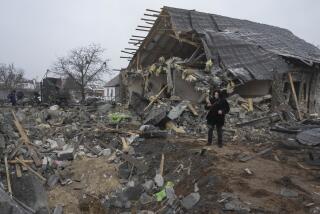It’s the Economy, Boris
- Share via
For weeks now, the world has watched with increasing unease as Russian President Boris N. Yeltsin has defended his economic reform program--and its top advocates within his government--from the hostile former Communists in the Congress of People’s Deputies, the Russian Parliament.
Sensing the program’s import, but also its growing unpopularity among the Russian people, Yeltsin recently deposed his leading advocate of market reforms, acting Prime Minister Yegor T. Gaidar.
Gaidar, who had initiated a radical “shock” program to shift Russia’s economy from state control to private enterprise, was replaced by Viktor S. Chernomyrdin, an oil industry executive.
Then, there was a shuffle of the Russian Cabinet, with Boris G. Fyodorov, a 34-year-old reform-minded economist, emerging as deputy prime minister in charge of economic policy. His appointment prompted new speculation as to the government’s course.
But, in a nutshell, for the Russian people, one issue remains an overriding concern. In the words of President-elect Bill Clinton’s campaign: “It’s the economy, stupid.”
And, as these figures show, the bottom line is bleak. The Russian economy is awash in red ink, unemployment, inflation and declining consumption.
What the Reformers Hope to Accomplish
Viktor S. Chernomyrdin replaced reformist acting Prime Minister Yegor T. Gaidar Dec. 14. Backed by President Boris N. Yeltsin, economic reformers have worked so far to:
* Privatize state-run enterprises by auction to the highest bidder or by sale through a system of giving Russian citizens vouchers with which to bid for shares of company stock.
* Introduce private land ownership and begin the privatization of state-run collective farms.
* End price controls and state subsidies on all but 15 major commodities, letting the market determine prices.
* Eliminate subsidies to state-run factories and farms, while limiting credit and the printing of money.
* Balance the national budget, or at least lower the deficit to 5% of Russia’s gross domestic product.
Inflation’s Rocky Ride
The most up-to-date inflation rates released by the government: Jan. 1992: 245 Feb. 1992: 38 March 1992: 30 April 1992: 22 May 1992: 12 June 1992: 19 July 1992: 11 Aug. 1992: 10
Sacrifices at the Food Table
Per person food consumption, before and after the reforms:
Jan-June 1991 Jan-June 1992 Meat products (pounds) 12.1 10.6 Milk and milk products (liters) 28.1 26.4 Eggs (number) 19 18 Bread (pounds) 18.2 17.6 Vegetables (pounds) 12.1 13.9 Potatoes (pounds) 18.5 19.1 Sugar and confectionery (pounds) 5.5 4.6
* Industrial production real growth rates
Source: Center for Economic Reform, Government of the Russian Federation, in their publication “Russian Economic Trends.”
More to Read
Sign up for Essential California
The most important California stories and recommendations in your inbox every morning.
You may occasionally receive promotional content from the Los Angeles Times.













